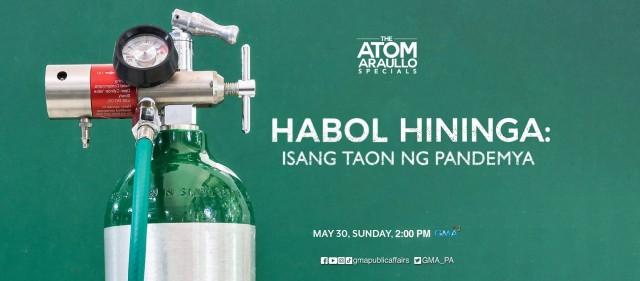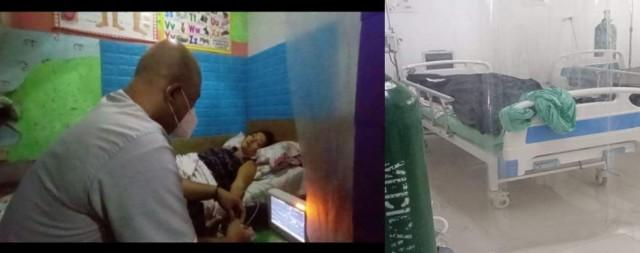'Habol Hininga: Isang Taon ng Pandemya,' mapapanood na ngayong Linggo!
THE ATOM ARAULLO SPECIALS: HABOL HININGA: ISANG TAON NG PANDEMYA

May 30, Sunday, 2:00 PM
Pumalo na sa mahigit isang milyon ang mga kaso ng COVID-19 sa Pilipinas, ang ika-26 na bansa sa buong mundo at pangalawa sa Southeast Asia na umabot sa bilang na ito.
Sa mga nakalipas na linggo, patuloy ang pagtaas ng mga kaso ng coronavirus. Isang taon simula nang tumama ang pandemya sa Pilipinas, sapat nga ba ang mga nagawang hakbang para pigilan ang paglobo ng mga kaso ng coronavirus?
April 21 nang malamang positibo sa COVID-19 si Eliza de Ocampo, 50 years old. Dahil sa malalang kondisyon at iba pang sakit, kailangan niyang ma-admit sa ospital pero wala silang mahanap na bakante. Napilitan ang kanyang pamilya na iuwi siya at doon ipagpatuloy ang paghahanap ng ospital. Sa kasamaang palad, matapos ang isang lingo, tuluyang binawian ng buhay si Eliza.
Sa Dr. Jose N. Natalio Rodriguez Hospital naman sa Tala, Caloocan, isang frontliner si Dr. Lisay. August 2020, sa kasagsagan ng kanyang duty, nagpositibo siya sa COVID-19. Gumaling at nakabalik siya sa trabaho. Pero sa pagsisimula ng surge ngayong 2021, ramdam daw nila ang pagod. May mga pasyenteng nasa pila, naghihintay na ma-admit sa ospital. Maging ang pamilya ni Dr. Lisay hindi nakaligtas sa virus. March 2021, nag-positive ang kanyang buong pamilya kabilang ang kanyang ina, tiyuhin at tatlong kapatid.
Sa Quezon City, kung saan may pinakamataas na kaso ng COVID-19 sa bansa, mas pinaigting ang testing at contact tracing. Ang buong pamilya ni Jessia Magculang nagdesisyong maging bahagi ng barangay frontliners. Si Jessica ay isang Barangay Health Emergency Response Team Officer at ambulance worker na taga-sundo ng mga pasyenteng dadalhin sa mga isolation facility. Ang asawa naman niyang si Melchor at anak na si Jam bahagi ng testing at contact tracing team.
Sa buong bansa, 255,854 ang kabuuang bilang ng contact tracers. Pero sabi mismo ng contact tracing czar, malaking hamon ngayon ang contact tracing sa bansa. Kung noong Pebrero, nasa 1:7 ang ratio, bumaba ito sa 1:3 nitong Marso at 1:4 noong Abril.
Punuan na rin ang ilang public crematorium dahil sa pagdami ng mga namamatay dahil sa COVID-19. Binisita ng aming team ang Baesa Crematorium sa Quezon City at Pasay City Crematorium. Base sa datos ng Pasay City Crematorium, 46 ang bilang ng na-cremate nitong Enero ngayong taon, 63 nitong Pebrero, at sumipa sa 405 nitong Marso 2021. Sa pangkalahatan, halos 18,000 na ang nasawi sa Pilipinas dahil sa Covid-19
Para mapigilan ang pagdami ng kaso, sinisimulan na ngayon ang mga vaccination drive. Target ng gobyerno na mabakunahan ang 70 milyong Pilipino para magkaroon ng tinatawag na herd immunity. Nitong unang linggo ng Mayo, nasa 2 million na ang nabakunahan. Sa bilang na ito, mahigit 320,000 pa lamang ang nakakumpleto sa second dose ng bakuna.
Ngayong Mayo 30, inihahandog ng The Atom Araullo Specials ang dokumentaryong HABOL HININGA: ISANG TAON NG PANDEMYA, isang napapanahong programang tatalakay sa mga hakbang ng gobyerno para mapigilan ang patuloy na pagtaas ng COVID-19 cases sa bansa---mula testing, tracing, isolation, treatment hanggang vaccination. Isang taon matapos tumama ang pandemiya, sapat ba ang ginagawa ng pamahalaan para tugunan ang mga problemang kaakibat ng Covid-19 sa Pilipinas?
English version
After battling one of the worst Covid-19 surges in the past weeks, the Philippines has logged in more than 1 million cases becoming the 26th country in the world and second country in Southeast Asia next to Indonesia to breach the mark. As the number of coronavirus cases increased during these weeks, hospitals went back in critical level, overwhelmed with patients. Some have died waiting in makeshift tents waiting to be admitted to the emergency rooms while some expired while in transit, in ambulances and at home without receiving any medical assistance.
Eliza de Ocampo, 50 years old, tested positive for COVID-19 on April 21. She was also discovered having diabetic ketoacidosis. The doctor informed her family that Eliza has to be admitted right away. However, their hospital was in full capacity and couldn't accommodate her. Instead, Eliza and her family were isolated at home, struggling to find a hospital as her condition worsened each day. Last April 29, after a week of searching for a hospital bed, Eliza succumbed to the disease.
In Dr. Jose N. Rodriguez Memorial Hospital in Caloocan, one of the country's public COVID-19 referral hospitals, Dr. Leslie Kimberly Lisay has been on the frontlines since the start of pandemic. In August 2020, Dr. Lisay was diagnosed as being Covid-19 positive. After recovering, she immediately returned to work to help other COVID patients. Early this year, she was shaken by the sheer number of patients in the hospital. And in March, her worst fears happened – her entire family tested positive for COVID-19. She was devastated with the news but did everything to help them recover.
To decongest the hospitals, government is set to build additional isolation and quarantine facilities. Unable to accept new patients, some private hospitals also now offer home care.
Quezon City, the country’s most populous city, recorded the most number of coronavirus infections in the country. To control the surge, contact tracing and testing program has been intensified. The entire family of Jessica Magculang decided to help in the fight against the spread of the virus. Jessica works as barangay health emergency response team officer and an ambulance worker, in-charge of transferring COVID positive patients to isolation facilities. Meanwhile, her husband Melchor and daughter Jam are part of contact tracing and testing teams. Jessica handled the first UK variant patient in the Philippines. Experts consider their roles as crucial in fighting the virus. Contact tracing involves calling and visiting those who have tested positive for COVID-19 or those who have been in contact with them.
Across the country, there are more than 250,000 contact tracers but the country’s contact tracing czar once admitted that contact tracing is failing. The national average contact tracing ratio in February was at 1:7, falling to a ratio of 1:3 in March and 1:4 in April, far from the target 1:15 ratio. This means that for each COVID-19 case detected, the close contacts who were traced had decreased from 7 to 3 and 4 persons respectively.
The rise in COVID-19 deaths has also placed a strain on some crematoriums in Metro Manila. Some are are struggling to keep up with the number of patients dying from the disease. Based on the Pasay City crematorium’s data, a total of 46 cadavers were cremated in January 2021. The number increased to 63 in February and further rose to 405 in March. Overall, Covid-19 has already claimed the lives of almost 18,000 Filipinos.
Last March, despite the delays, the Philippines launched vaccination campaigns but vaccination in the country faces hurdles including public mistrust and limited supply. The government aims to vaccinate up to 70 million Filipinos by the end of the year to achieve herd immunity. More than a month since the start of vaccination drive, just about 2 million doses have been administered with only 320,000 individuals fully vaccinated.
The country’s longest lockdown and most deadly surge have posed risks to the quality of healthcare and left medical professionals and other frontliners exhausted. Between the challenges of tracing, testing and treating COVID-19, Dr. Lisay and Jessica have reason for hope— that this pandemic shall eventually pass.
This May 30, The Atom Araullo Specials presents HABOL HININGA: ISANG TAON NG PANDEMYA, a relevant documentary which tackles the Philippines response to COVID-19---from testing, tracing, isolation, treatment to vaccination—and examines the different programs of government against the pandemic. One year since the pandemic hit the Philippines, is the government’s response enough and effective amidst the various challenges of Covid-19?








